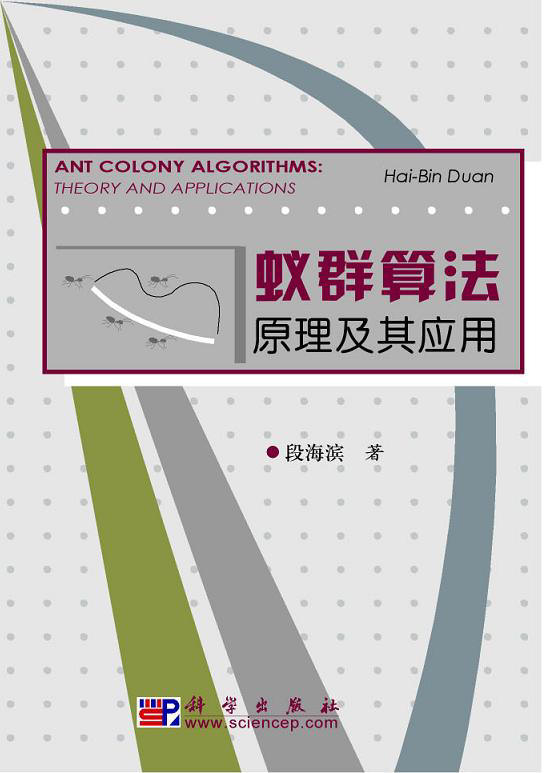|
Contents
Preface
Abstract
Chapter 1 Introduction
1.1 Introduction
1.2 Biological Characteristics of Ants
1.3 Idea Origins of Ant Colony Algorithm(ACA)
1.4 Development of ACA
1.5 Outline of the Book
1.6 Summary
References
Chapter
2 Principles and Complexity Analysis of Basic ACA
2.1 Introduction
2.2 Principles of Basic ACA
2.3 Systematic
Characteristics of Basic ACA
2.4 Mathematical Model of Basic ACA
2.5 Implementation of Basic ACA
2.6 Complexity Analysis of Basic ACA
2.7 Performance Criteria
of Basic ACA
2.8 Summary
References
Chapter
3 Convergence Proofs for ACAs
3.1 Introduction
3.2 Convergence Proof for the Gragh-based Ant System(GBAS)
3.3 Short Convergence Proof for a Class of Improved ACA
3.4 Deterministic Convergence Proof for GBAS/tdev and GBAS/tdlb
3.5 A. S. Convergence Proof for
Basic ACA
3.6 Convergence Results for a Class of Distributed Ant Routing Algorithms
3.7 Branching Process and Branching Wiener Process based ACA
3.8 Convergence Analysis for a
simple ACA
3.9 Markov Convergence Analysis for the Combination of ACA and Genetic
Algorithm
3.10 Convergence Analysis for
a Class of Generalized ACA(GACA)
3.11 Summary
References
Chapter
4 Experimental Analysis of ACA and Optimum Configuration Principles of
Pertinent Parameters in ACA
4.1 Introduction
4.2 Experimental Analysis of the Effect of Pertinent Parameters and Ant
Colony Behaviors in ACA
4.3
“Three-step”
Method for Optimum Configuration of Pertinent Parameters in ACA
4.4 Summary
References
Chapter
5 Improved ACAs in Discrete Space Optimization
5.1 Introduction
5.2 Self-adaptive ACA
5.3 Cross-romoving and Local Optimization Strategies based ACA
5.4 Pheromone Diffusion based ACA
5.5
Polymorphic
ACA
5.6 Model-learning based Little-window ACA
5.7
Hybrid
Behavior based ACA
5.8 Improved ACA with Clustering
5.9 Cloud Models Theory based ACA
5.10
Sensational
and Consciousness ACA
5.11 Improved ACA with Random Perturbation Behavior
5.12 Information Entropy based ACA
5.13 Summary
References
Chapter
6 Improved ACAs in Continuous Space Optimization
6.1 Introduction
6.2 Gridding Partion based ACA
6.3 Trail Distributed Function based ACA
6.4 Self-adaptive ACA for Solving Continuous Space Optimization Problems
6.5 Cross and Mutation Operation based ACA
6.6 Improved ACA with Embedded Deterministic Searching
6.7 Dense Heterarchy Continuous Interacting ACA
6.8 Improved ACA for Multiobjective Optimization Problems
6.9 Dynamic-window-search ACA for Complex Multistage Decision-making
Problems
6.10 Summary
References
Chapter
7 Typical Applications of ACA
7.1 Introduction
7.2 Job-shop Scheduling Problem(JSP)
7.3 Network Routing Problem
7.4
Vehicle
Routing Problem(VRP)
7.5 Robot Field
7.6 Power System
7.7 Fault Diagnosis
7.8 Parameter Optimization
7.9 System Identification
7.10 Clustering Analysis
7.11 Data Mining
7.12 Imagine Processing
7.13 Route Planning
7.14 Air-combat Decision-making
7.15
Geotechnical
Engineering
7.16 Chemical Industry
7.17 Life Science
7.18 Layout Optimization
7.19 Summary
References
Chapter 8 Hardware Realization of ACA
8.1 Introduction
8.2 Overview of
Bio-inspired
Hardware
8.3 FPGA Implementation of ACA
8.4 Hardware/Software Partioning based on Dynamic Combination of ACA and
GA
8.5 Summary
References
CChapter 9 Comparison and Combination of ACA and Other Bio-inspired
Optimization Algorithms
9.1 Introduction
9.2 Principles of Several Typical Bio-inspired Optimization Algorithms
9.3 Comparison of ACA and Other Bio-inspired Optimization Algorithms
9.4 Combination of ACA and GA
9.5 Combination of ACA and
Artificial
Neural Network (ANN)
9.6 Combination of ACA and
Particle
Swarm Optimization (PSO)
9.7 Combination of ACA and
Artificial
Immune Algorithm (AIA)
9.8 Summary
References
Chapter 10 Prospects
10.1 Introduction
10.2 Model Improvement of ACA
10.3 Theoretical Analysis of ACA
10.4 Parellelization of ACA
10.5 Application Fields of ACA
10.6 Hardware Realization of ACA
10.7 Intelligent Combination of ACA
10.8 Summary
References
Appendix A: Programs of Basic ACA
A.1 C Language Version
A.2 Matlab Language Version
A.3 Visual Basic Language
Version
Appendix B:
Web Sources about ACA
Appendix C: terminology (Chinese-English)
and Abbreviations
Appendix D:
(Poetry) Zhe Hu Tian·ACA
         
BACK
|
